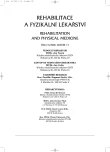Diagnostic of Temporomandibular Disorders
Authors:
K. Velebová; D. Smékal
Authors‘ workplace:
Katedra fyzioterapie, Fakulta tělesné kultury, Olomouc
vedoucí prof. MUDr. J. Opavský, CSc.
Published in:
Rehabil. fyz. Lék., 13, 2006, No. 3, pp. 134-144.
Category:
Original Papers
Overview
The temporomandibular joint is one of the most complicated joints - anatomically, kinesiologically and functionally. Perfect coordination of muscular activity is required for optimum function of the temporomandibular joint, not only of the muscles of the stomatognatic system but also of the cause a secondary temporomandibular joint disorder. Temporomandibular joint disorders may also be secondary to psychological disturbance: anxiety, depression. A characteristic triad of symptoms is associated with temporomandibular disorders: pain in the temporal region, disorders of mandibular movements and joint clicking.
Key words:
temporomandibular joint, temporomandibular disorder, diagnostic
Labels
Physiotherapist, university degree Rehabilitation Sports medicineArticle was published in
Rehabilitation & Physical Medicine

2006 Issue 3
Most read in this issue
- Stability of the Motor System and the Deep Stabilizing System - Principles and Clinical Application
- Diagnostic of Temporomandibular Disorders
- Statistical Properties of a New Scale - Score for Visual Evaluation of Functional Task of the Hand in Patients after Stroke
- Magnetic Resonance in the Early Diagnostics of Rheumatoid Arthritis
